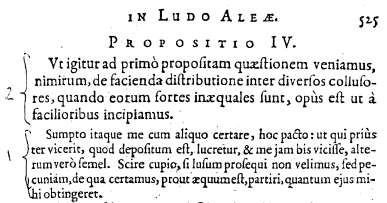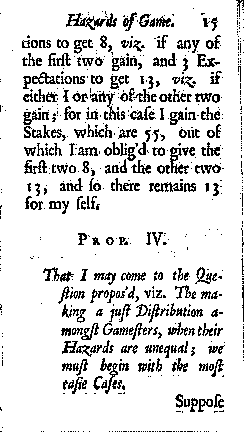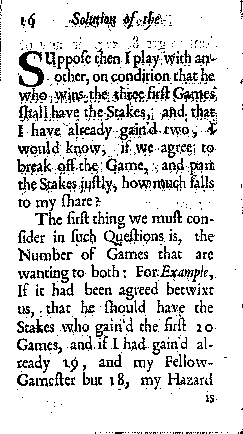Notice that in general Huygens' kans is best translated as occasion, and not as probability
Incorrect references to Proposition II in stead of Proposition III, that occur in Propositions X to XIII, suggest that Proposition II had been ommitted for some time, only to be put back at the last moment. This must have been before Proposition XIV was entered, because it contains two correct references to Proposition II.
Of the two errors in 1657 in mathematical expressions in Proposition III only the second one remained: in the text it still says qx+bx-bq-ap-a in stead of px+qx-bq-ap-a.
In Proposition IV the order of the first two paragraphs is correct. In Proposition IX however the order of the first two paragraphs 'Om tusschen...' and 'Zy genomen...' seems to be reversed, when compared with the other propositions.
 The error in the order of the first two
paragraphs of Proposition IV was already noted by Huygens in letter to Van
Schooten of september 28, 1657 He also detected the 'horum' which should have been
'hae' in the first paragraph of Proposition IX.
The error in the order of the first two
paragraphs of Proposition IV was already noted by Huygens in letter to Van
Schooten of september 28, 1657 He also detected the 'horum' which should have been
'hae' in the first paragraph of Proposition IX.Incorrect references to Proposition II in stead of Proposition III, that occur in Propositions X to XIII, suggest that Proposition II had been ommitted for some time, only to be put back at the last moment. This must have been before Proposition XIV was entered, because it contains two correct references to Proposition II.
Two errors in mathematical expressions in Proposition III: in the text of the proposition itself it says (pa+pb)/(p+q) in stead of (pa+qb)/(p+q), as Stigler in 1992 already noted in his Apollo Mathematicus: "the first typographical error in the history of mathematical probability"; in the text it says qx+bx-bq-ap-a in stead of px+qx-bq-ap-a.
In Proposition IX the order of the first two paragraphs 'Ut tot...' and 'Ponamus...' seems to be reversed, when compared with the other propositions.

 The first mishap which occurs at proposition IV (page 15),
follows the error of the Latin 1657 edition: the text of this proposition and that
of the next paragraph are exchanged (see picture on the left). So the text
of the proposition is now set in the font of the normal text, while the
text of the paragraph that originally followed, is now italicized like the
other propositions.
The first mishap which occurs at proposition IV (page 15),
follows the error of the Latin 1657 edition: the text of this proposition and that
of the next paragraph are exchanged (see picture on the left). So the text
of the proposition is now set in the font of the normal text, while the
text of the paragraph that originally followed, is now italicized like the
other propositions.The next mistake occurs in Problem V where ...that if 12 comes up... should have been ...that if 11 comes up.... As this changes the problem it seems important enough to mention.
Richard Mead (11 Aug. 1673-16 Feb. 1754) to whom Browne dedicated his translation, wrote De Imperio Solis ac Lunae in Corpora Humana, et morbis inde oriundis (A Treatise Concerning the Influence of the Sun and the Moon on Human Bodies) (1704). It is amply referred to by Brown in the dedication, who suggested that Medicine could benefit from the calculus of probabilities.
In general Browne is succesful in translating the Latin text by Van Schooten. In at least three instances however he trips and leaves the reader puzzled.
 The first mishap which occurs at
proposition IV (page 7), follows the error of the Latin 1657 edition: the
text of this proposition and that of the next paragraph are exchanged (see
picture on the left). So the text of the proposition is now set in the font
of the normal text, while the text of the paragraph that originally
followed, is now italicized like the other propositions.
The first mishap which occurs at
proposition IV (page 7), follows the error of the Latin 1657 edition: the
text of this proposition and that of the next paragraph are exchanged (see
picture on the left). So the text of the proposition is now set in the font
of the normal text, while the text of the paragraph that originally
followed, is now italicized like the other propositions. The second mishap occurs in the text of proposition XIII and is a matter of translation. In comparison with the other texts it appears that Brown completely misses the point of the second half of the text starting from ..and after this Bargain made..
The third mistake occurs in Problem IV where ...3 black ones... should have been ...3 white ones.... As this changes the problem it seems important enough to mention.
The question rises: what does the French text represent? The layout of the earlier (front) pages suggests that the French text might be a continuation / translation of the Latin text. And I believe that several later authors such as David and and to a lesser extent Dupont & Roero have been duped by this suggestion. The French text is in reality a translation of the facing Dutch text as a comparison of the Dutch, French and Latin texts clearly shows.
How can you tell if someone has used this French translation? One approach is to look for words that are specific for the French text. Huygens writes in his letter to Van Schooten 'Doch sy luyden' when talking about the French mathematicians, Van Schooten translates this correctly as 'Cæterum illi'. Korteweg however translates 'Mais ces savants' which adds an extra explanation to the translation. David has 'But these savants' and Dupont & Roero 'Tuttavia questi illustri studiosi'. And there are other cues that give away on which source a translation is based.
The French translation by Korteweg of the Dutch text was probably intended to convey the meaning of the Dutch text, and not so much to give an idea of the phrasing. See e.g. the first three propositions where Ick ... hebbe had to give way to the rather impersonal Avoir. Apart from an occasional spelling error (see proposition IX), there is a sometimes less than happy choice of wording (eg proposition XIV: where one reads rapport for reden, in stead of ratio, raison or proportion).
Sometimes there is also some (unnecessary) explanation involved. Propositions XIII and XIV both started originally with Als. In the French translation of proposition XIV this becomes Si as one would expect. Proposition XIII however starts rather unexpectedly with Dans l'hypothèse que. I rest my case.
In the translation of proposition IX, the last sentence is left out for no appearent reason.
In the translation of problem III, the last sentence is probably left out because David suggests in a footnote on p 119 that both Huygens and Todhunter are wrong in their calculation of the answer.